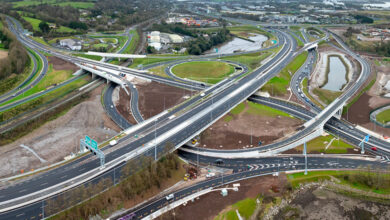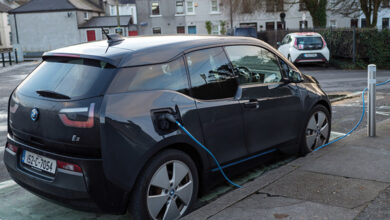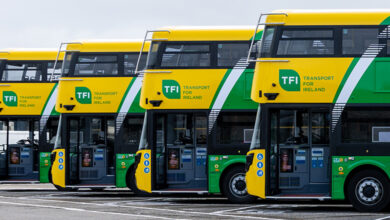Decarbonising Irish transport

The most significant challenge facing the transport sector is striking a balance between facilitating growth in travel demand while simultaneously decarbonising. As such, Ireland requires a fundamental change in how journeys are undertaken.
With projected population growth of approximately one million people by 2040, Ireland’s transport system will be fundamental to the delivery of the Government’s long-term spatial strategy to accommodate growth, the National Planning Framework (NPF). Indeed, included among the 10 National Strategic Outcomes, the priorities of NPF, are compact urban growth, improved accessibility, robust rural communities, sustainable mobility, and decarbonisation. The National Investment Framework for Transport in Ireland (NIFTI) is the Government’s framework for future investment in the land transport network to enable the delivery of the National Strategic Outcomes.
Decarbonising transport is an crucial component in the context of halving Ireland’s greenhouse gas emissions by 2030. Excluding international aviation, at 12.2 MtCO2eq, transport emissions account for 20 per cent of Ireland’s greenhouse gas emissions, with road transport responsible for 96 per cent of these emissions.
Even with severe public health restrictions in 2020, emissions reduced by only 16 per cent when compared with 2019. As such, delivering a 51 per cent reduction in transport emissions by 2030 will be a sizeable challenge.
As acknowledged in Climate Action Plan 2021, the built environment must evolve from one that is vehicle centred to one that is people centred, primarily through the creation of 15-minute neighbourhoods. Practically, this concept is defined by people to living and accessing most of their daily needs within a 15-minute journey via sustainable modes of transport.
Speaking with eolas, Transport Minister Eamon Ryan TD acknowledges the decarbonisation challenge in transport, specifically referencing “the development patterns in transport over the last 50 years have steered us towards a more dispersed car-dependent model, a haulage system reliant on diesel,” adding: “How we change that is more complex.”
Several actions will underpin the decarbonisation of transport, including a shift to sustainable modes of transport and the electrification of vehicle fleets.
Sustainable mobility
Sustainable mobility is contingent on the provision of “reliable and realistic” transport alternatives to complete everyday journeys. As such, unprecedented investment in active travel and public transport infrastructure is required. With an objective of delivering an additional 500,000 sustainable journeys each day by 2030, the Government has committed to:
• BusConnects;
• Connecting Ireland;
• expanding rail service and infrastructure; and
• investing in walking and cycling.
Additional measures to promote sustainable mobility include:
• electric scooter legislation;
• support for local authorities to expand shared mobility schemes;
• promotion of cargo bicycle use; and
• enhanced road safety awareness.
Delivery
Reflecting on sustainable mobility delivery, Minister Ryan outlines: “The Department of Transport will be leading; bringing in agencies like the National Transport Authority and Transport Infrastructure Ireland, local authorities, and regional assemblies, working in teams, and breaking down the silos that sometimes exist in the public service.
“In that case, we look and ask how we can accelerate BusConnects in all five cities, how can we accelerate and deliver the new Connecting Ireland rural transport system, and it is all about delivery.”
Acknowledging the challenge of delivery, “across a whole range of different areas of government”, as a consequence of the permitting and contracting process, the Minister adds: “What I am saying about the acceleration is in public transport infrastructure, not just the metro, but DART+, and rail plans in Cork, Limerick, Galway, and Waterford.
“A signal on that was given in the European Recovery and Resilience Fund. We had money from Europe and spent it on metropolitan rail in Cork for one. These projects will still take time, rail projects by their very nature do. The MetroLink, no matter how it’s done, is a five-seven-year timeframe. We will bring that to government shortly and we need to get it through the planning system.”
Fleet electrification
Currently, there are approximately 45,000 electric vehicles registered in Ireland and until total cost of ownership parity is reached with internal combustion engine cars, cost will remain a obstinate barrier to EV uptake. Meanwhile, while technological advances are soothing range anxiety, the public charging network and electricity grid capacity must develop in parallel to facilitate for a much larger EV fleet.
Ultimately, a wholesale transition to EVs is contingent on:
• expansion of the EV charging network;
• ensuring electricity grid readiness;
• reviewing and updating fiscal and regulatory incentives;
• reviewing and amending building regulations with regard to charging points;
• supporting a shift towards electric vans;
• transitioning the public transport fleet to low emission alternatives; and
• mandating the conversion of public sector fleets to EVs.
It is apparent that the realisation of the National Planning Framework by 2040, alongside the legally binding Climate Act 2021 ambition net-zero greenhouse gas emissions no later than 2050, and a reduction of 51 per cent by 2030 will require significant additional investment in public transport and active travel assets.
However, with a transport budget of €35 billion for the coming decade and €70 billion worth of transport projects in varying stages of planning and development, this will be difficult.
“We are looking to see how we can deliver the most for the budget we have, particularly at this time of inflation. We need to take what we learned during Covid and Brexit as to how the public service can be quick and responsive, and that’s the key,” the Transport Minister insists.
|
Climate Action Plan 2021 Containing 71 transport specific actions, the Climate Action Plan for transport aligns with several national policy plans, including Project Ireland 2040, the National Planning Framework (NPF), the National Remote Work Strategy, the National Adaptation Framework, Our Rural Future, and the Sustainable Mobility Policy. Climate Action Plan 2021 requires an emissions reduction of between 5.2 and 6.2 • providing an additional 500,000 daily public transport and active travel journeys; • developing the required infrastructural, regulatory, planning, and financial context to support improved system, travel, vehicle, and demand efficiencies; • increasing the electrical vehicle and low emitting vehicle fleet on Irish roads to 945,000 vehicles (including 845,000 passenger cars, 95,000 electric vans, 3,500 low emitting trucks, 1,500 electric buses, and an expanded electrified rail network); • raising the blend proportion of biofuels to B20 in diesel and E10 in petrol; • reducing internal combustion engine vehicle kilometres by 10 per cent compared with present day figures; and • undertaking a programme of work to review, progress, and refine measures that deliver an additional 0.9 MtCO2eq. by 2030 “in a fair and equitable manner”. |
Simultaneously, the Government reiterated its commitment to a 2:1 ratio for expenditure on new public transport infrastructure and new roads in the Programme for Government, in parallel to a €360 million investment in active travel each year.
|
NIFTI In December 2021, the Government also published the new National Investment Framework for Transport in Ireland (NIFTI), in which it established the principles of future transport investment. Replacing the 2015 Strategic Investment Framework for Land Transport, NIFTI sets out four strategic investment priorities to address transport challenges. These are: 1. decarbonisation; 2. protection and renewal; 3. mobility of people and goods in urban areas; and 4. enhanced regional and rural connectivity. The objective of NIFTI is to ensure that a balance is met between the protection and renewal of existing transport infrastructure, and the development of new assets. Establishing investment priorities and how investment will be undertaken, its primary function is as a tool for the development of proposals for future transport investment. Project sponsors are required to demonstrate their projects’ alignment with the NIFTI’s four priorities. |





